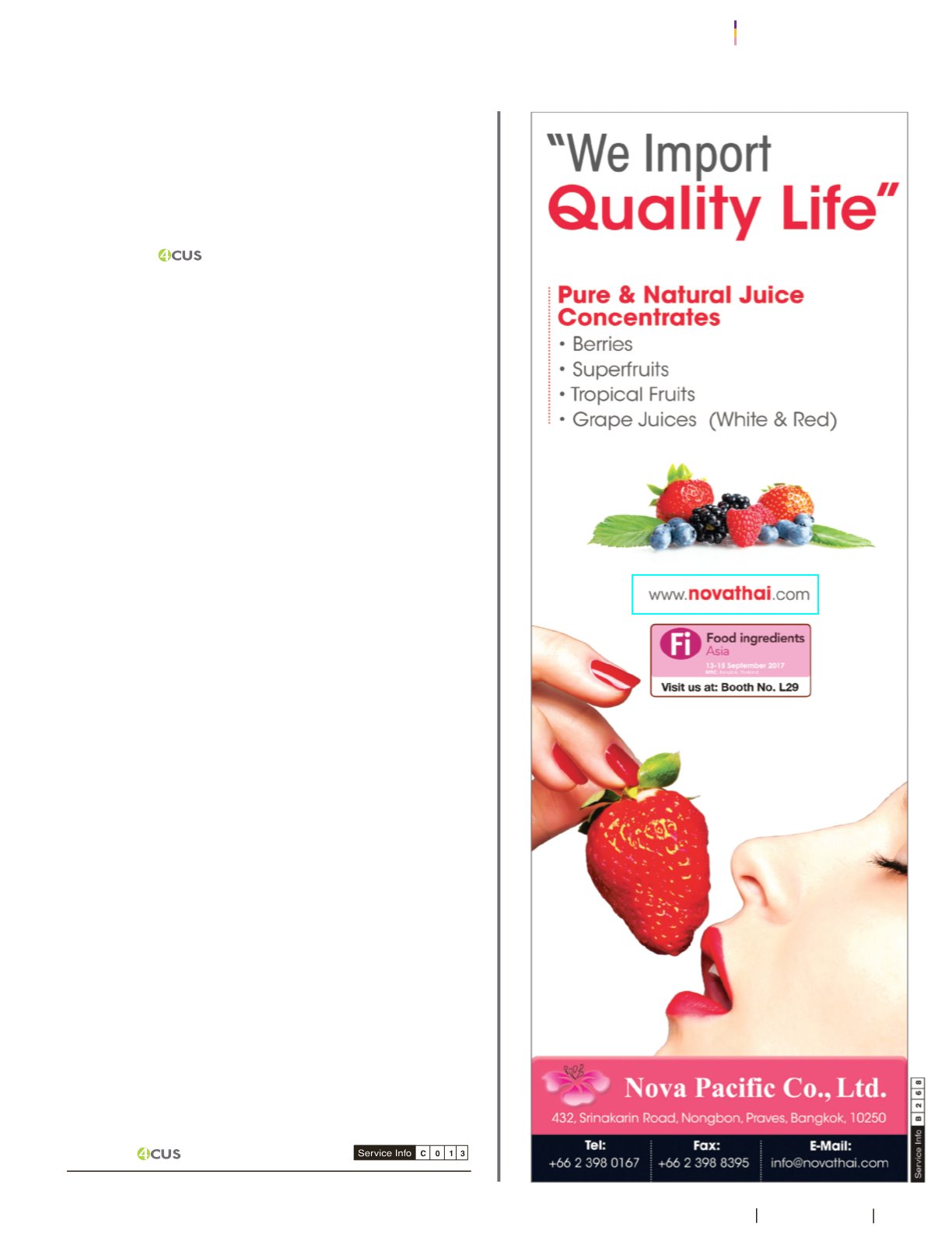
83
SEP 2017 FOOD FOCUSTHAILAND
STRONG
QC & QA
เอกสารอ้
างอิ
ง/Reference
/
health/CR_FSASC_FromCroptoTablePesticides_Mar2015.pdf
In fact, a recent ConsumerReports surveyof 1,050people found
that pesticides are a concern for 85 percent of Americans. So, are
theseworries justified?Andshouldweall bebuyingorganics—which
can cost an average of 49 percent more than standard produce?
Experts at Consumer Reports believe that organic is always the
best choicebecause it isbetter for your health, theenvironment, and
thepeoplewhogrowour food.The risk frompesticidesonconventional
produce varies from very low to very high, depending on the type of
produceandon the countrywhere it’sgrown. Thedifferences canbe
dramatic. For instance, eating one serving of green beans from the
U.S. is200 times riskier thaneatinga servingof U.S.-grownbroccoli.
“We’reexposed toacocktail of chemicals fromour foodonadaily
basis,” says Michael Crupain, M.D., M.P.H., director of Consumer
Reports’ Food Safety and Sustainability Center. For instance, the
Centers for Disease Control and Prevention reports that there are
traces of 29 different pesticides in the averageAmerican’s body. “It’s
not realistic to expect wewouldn’t have any pesticides in our bodies
in this day and age, but that would be the ideal,” says Crupain. “We
just don’t know enoughabout the healtheffects.”
PesticidesUsedBeforeandAfter Plant Cultivation
Whenpeople thinkofpesticidesapplied tocrops, theyprobablypicture
an airplane flying over a farm field, or a truck with a sprayer driving
through an orchard, spraying pesticides on the crops while they are
growing.But in thecaseofmanypesticides,application isoftenapplied
to seeds, soil, and crops before and after theactual growing period.
For example, onsome fruitsandvegetables, one-third toone-half
of the residues are frompesticides that were not applied in the fields
or orchards but in storage. Somepesticides applied in storage target
insects, but others are used to lengthen the shelf life of the produce.
For example, many types of fruit, suchas oranges and peaches, are
treatedwitha fungicide to inhibitmold.Chemicalscanalsobeapplied
to vegetables after harvest to prevent sprouting.
In thecaseof seeds, fungicidesmaybeappliedduringstorage to
preventmolding,or theseedsmaybe individuallycoated inpesticides
as a prophylactic pest treatment. Additionally, pesticides in the form
of gas, known as fumigants, are often injected into the soil prior to
planting to sterilize the fields from subterraneanpests.
CanYouWashAwayPesticides?
About half of thepeople ina recentConsumerReportssurveybelieve
that peeling fruit or vegetables removesor reducespesticidesand43
percent think you can remove them by washing: And they’re right—
sort of. Rinsing can remove the surface residues, aswell as dirt and
bacteria. But you can’t completelywash away the pesticides—or the
risk. Pesticides can stick to soft skins, and the wax coating used on
some produce can trap pesticide residues. And some pesticides are
systemic, that is they are takenupby theplant’s root systemandget
into the fruitorvegetablefleshso theycan’tbewashedoff.What’smore,
theUSDAmeasurespesticide residuesafterproducehasbeen rinsed
in cold runningwater and/or inedible peels and rinds are removed.
Washyourproduce—conventionalandorganic—in runningwater.
You don’t need any special washes. Researchers at theConnecticut
AgriculturalExperimentStationcompared rinsing fruitandvegetables
inplainwater foroneminutewithwashing themwithvegetablewashes
(four different ones) and a solution of dishwashing soap and water.
Water alonewas as effectiveas any of thewashes or soap. Rubbing
produce with soft skins like peaches or using a vegetable brush on
harder items like potatoes or carrots will help remove residues, dirt
andgerms.
อย่
างไรก็
ตาม ก็
ไม่
จ�
ำเป็
นที่
จะต้
องสรรหาวิ
ธี
ล้
างที่
พิ
เศษไปจากการล้
างด้
วย
น�้
ำสะอาดไหลผ่
าน นั
กวิ
จั
ยจากสถานี
ทดลองทางการเกษตรได้
แสดงผล
การเปรี
ยบเที
ยบการล้
างผั
กและผลไม้
ในน�้
ำเปล่
าเป็
นเวลา 1 นาที
เที
ยบกั
บน�้
ำยาล้
าง
ผั
กสี่
ชนิ
ดแตกต่
างกั
นน�้
ำยาล้
างจานและน�้
ำพบว่
าการใช้
น�้
ำเพี
ยงอย่
างเดี
ยวก็
มี
ผล
เช่
นเดี
ยวกั
บการล้
างด้
วยน�้
ำยาล้
างจาน นอกจากนี้
การใช้
มื
อถู
เช่
น ลู
กพี
ช หรื
อ
การใช้
แปรงช่
วยถู
เช่
น มั
นฝรั่
งหรื
อแครอทก็
จะช่
วยขจั
ดคราบสกปรกและเชื้
อโรค
ได้
ในอี
กทางหนึ่
ง


